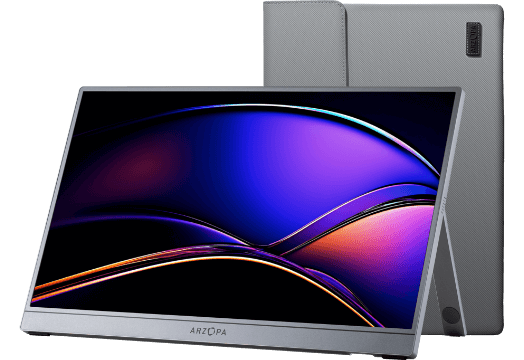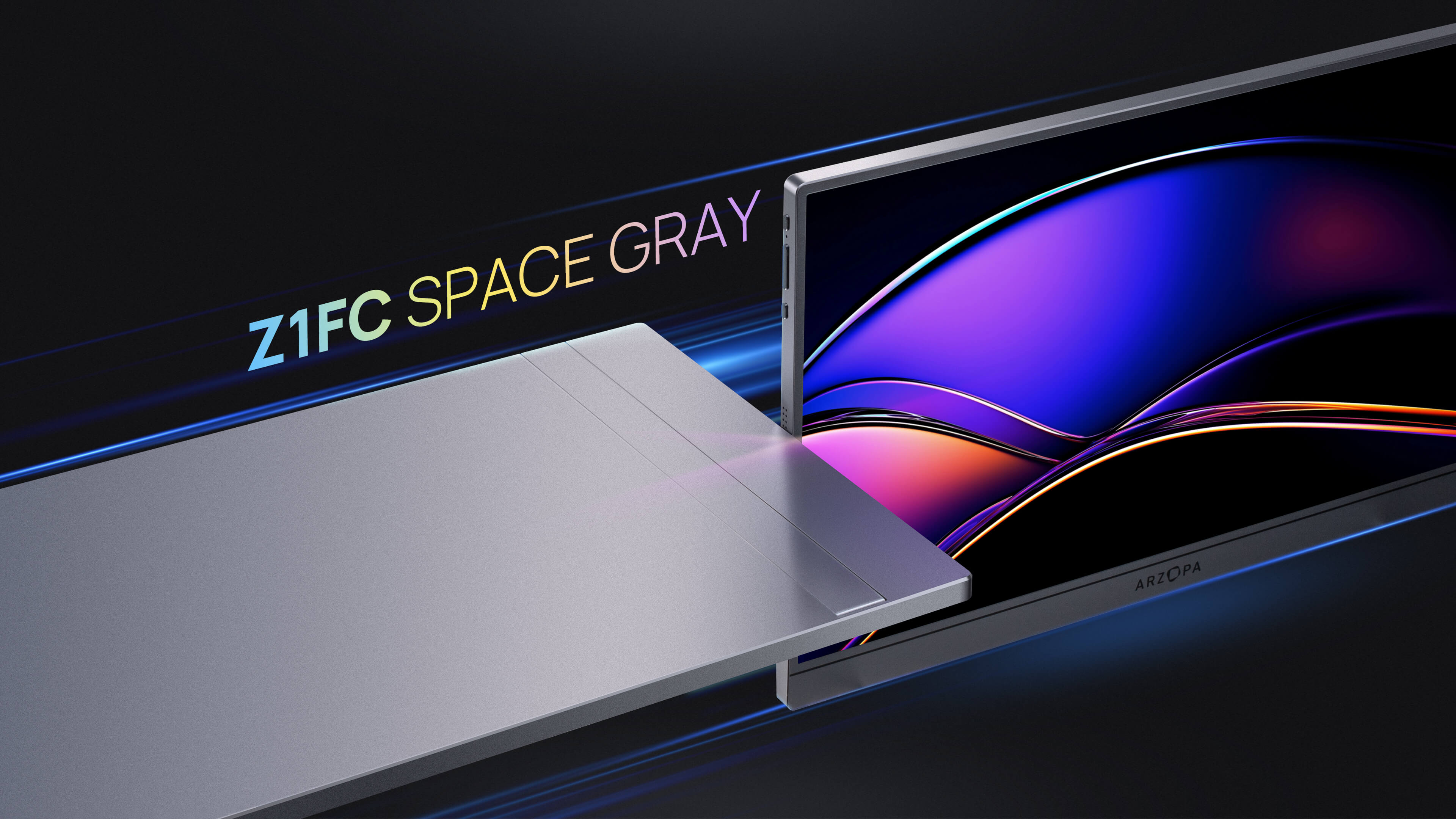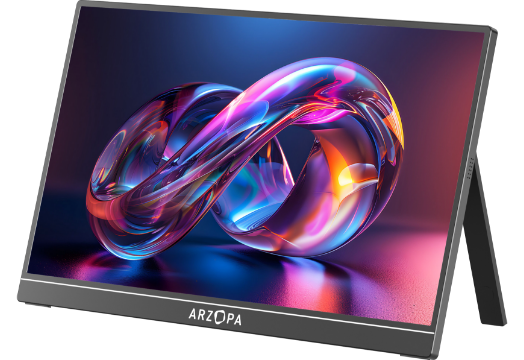Portable Monitor for Video Production
In the fast-evolving world of video production, creators need tools that are portable, powerful, and precise. Whether you're editing on a train, color grading on set, or previewing footage during a shoot, the right monitor can streamline your workflow and elevate your results. That’s why more professionals are turning to portable monitors — and one model stands out: the Arzopa Z1RC 16.1” Portable Monitor.
In this blog, we’ll explore how this monitor is transforming the video production process, answer common questions like whether 1080p is enough or if 4K is necessary, and help you decide if the Z1RC belongs in your gear bag.
Why Video Professionals Need a Portable Monitor?
Video editors and filmmakers often find themselves working outside the traditional studio. From hotel rooms to client sites, the need for a reliable, lightweight second screen has never been greater.
Key Benefits of Using a Portable Monitor
-
Extended workspace to manage timelines, preview windows, and tools without clutter
-
Real-time camera monitoring during shoots
-
Color reference for accurate grading on the go
-
Client playback for a polished presentation anywhere
"Having a second screen while editing remotely has completely changed how I work. The Arzopa Z1RC portable monitor gives me clarity and flexibility." — Sarah M., Video Editor

What kind of Portable Monitor do I Need for Video Editing?
For portable video editing, you’ll want a display that balances color accuracy, resolution, and connectivity in a slim, lightweight package. Look for an IPS‑based panel - its wide viewing angles and stable color reproduction ensure your grades stay consistent even as you move.
A Full HD (1920×1080) portable monitor works well for HD projects and conserves battery life, but if you need more workspace for timelines and scopes, a higher‑res option like 2560×1600 (WQXGA) gives you extra vertical space without the GPU tax of 4K. That 16:10 aspect ratio is particularly handy for fitting your editing software’s toolbars and waveform displays.
Make sure your monitor supports both USB‑C (with DisplayPort Alt Mode) and HDMI so you can hook up laptops, cameras, and other gear with a single cable if possible. Finally, choose a model with at least 100 % sRGB color coverage and factory calibration (or hardware calibration support) so what you see on the go matches your final output.
In short, a USB‑C–powered 16″ IPS portable monitor at either 1080p for efficiency or 2560×1600 for extra screen real estate - backed by full‑sRGB accuracy - is the ideal on‑the‑move editing companion.

What Are the Disadvantages of a Portable Monitor for Video Editing?
While portable monitors offer clear advantages, it's important to understand their limitations:
-
Lower brightness in direct sunlight
-
Color calibration can vary; not all models support accurate color reproduction
-
USB-C-only designs may limit compatibility with older devices
The Arzopa Z1RC addresses these issues with support for both USB-C and HDMI, plus full 100 percent sRGB color gamut for accuracy.
Arzopa Z1RC Portable Monitor: Built for Creators
The Arzopa Z1RC 16.0" Portable Monitor offers the perfect blend of size, portability, and performance for modern video creators.
Whether you’re editing footage, reviewing scenes, or managing timelines, the Arzopa Z1RC Portable Display delivers reliable performance on the move.
Do You Need a 4K Portable Monitor for Video Editing?
You don’t always need a 4K monitor to edit video. While 4K displays are ideal for reviewing ultra-high-definition content, many professional workflows still rely on 1080p screens, especially for editing on the go.
When is 4K Portable Monitor Essential?
You may need a 4K monitor if:
-
You are editing and delivering content in 4K or higher (like 6K/8K footage)
-
You do detailed color grading, masking, or effects work
-
You need a large workspace to view multiple windows at once
-
You want to preview videos at full resolution without scaling

What About 2560×1600 (WQXGA) Portable Displays?
One excellent middle-ground option is a 2560×1600 (WQXGA) monitor. Compared to the standard 1080p, this resolution offers significantly sharper detail and a 16:10 aspect ratio, which gives you extra vertical space. That makes it easier to manage timelines, effect layers, and tool panels in editing software. More importantly, it delivers better clarity without putting too much strain on your laptop's graphics performance or battery life. For creators who need mobility and screen space, 2560×1600 strikes a smart balance.
For creators who value both mobility and screen quality, a 2560×1600 display can be a perfect match. It's especially useful for editing HD and 2.5K content with more vertical workspace.
Why 1080p Portable Monitor Still Works?
Even so, 1080p (Full HD) remains a practical and popular choice - especially in portable monitors. It’s highly compatible across platforms, light on power, and provides sharp visuals on screens around 16.1 inches, like the Arzopa Z1FC portable monitor. Unless your workflow demands ultra-high detail or precise resolution matching, a good 1080p display with accurate color reproduction can meet the needs of most video editors.
Unless your workflow demands ultra-high detail or delivery in 4K, a high-quality 1080p portable monitor like the **Arzopa Z1FC portable display offers excellent color accuracy and performance for most video editors.
However, 4K monitors can drain laptop performance and battery life. They also require more GPU power, which may not be ideal for creators on the go.

Is a 60Hz Monitor Good for Video Editing?
A 60Hz monitor - refreshing its image sixty times per second - remains perfectly adequate for most video editing tasks. Since standard video projects typically run at 24, 30, or 60 frames per second, a 60Hz display can faithfully render each frame without dropping or duplicating, ensuring smooth playback in your NLE (non‑linear editor). Editors won’t encounter motion judder when scrubbing clips, and color grading remains unaffected by refresh rate.
Where you might notice a benefit from higher refresh (75Hz or above) is during rapid timeline navigation or when previewing high‑frame‑rate footage (such as 120 fps slow‑motion). The slight increase in refresh rate can make scrubbing feel more responsive, but it does not directly improve color accuracy, contrast, or resolution - all of which are more critical to video editing quality.
In short, if you’re working primarily with conventional frame rates and value color fidelity and resolution above all, a reliable 60Hz IPS monitor - especially one with full‑screen color coverage like the Arzopa Z1RC - will serve your editing workflow exceptionally well.
Best Portable Monitor for Video Editing 2025
Arzopa Z1RC 16″ Full HD Portable Monitor
• 2560×1600 IPS panel with 100 % sRGB
• 60 Hz refresh rate, built‑in dual speakers
• USB‑C (DisplayPort Alt Mode) + HDMI inputs
• Ultra‑slim 1.5 lb design with smart cover stand
• Best balance of battery‑friendly efficiency and color fidelity

Lepow 15.6″ QHD Portable Monitor
• 2560×1440 IPS, 95 % DCI‑P3
• 75 Hz refresh, USB‑C & mini‑HDMI
• 1.7 lb with foldable smart cover
• Excellent mid‑range option for crisp QHD editing

ASUS ProArt PQ14U 14″ Full HD Portable Monitor
• 1920×1080 IPS with 100 % sRGB & Calman Verified
• 60 Hz refresh, USB‑C single‑cable connectivity
• 1.6 lb with built‑in adjustable stand
• Targeted at creative professionals needing factory calibration

| Monitor | Resolution | Color Coverage | Weight | Connectivity | Best For |
|---|---|---|---|---|---|
| Arzopa Z1RC | 2560×1600 | 100 % sRGB | 1.5 lb | USB‑C + HDMI | Battery‑friendly QHD editing |
| Lepow | 2560×1440 | 95 % DCI‑P3 | 1.7 lb | USB‑C + mini‑HDMI | Mid‑range QHD option |
| ASUS ProArt | 1920×1080 | 100 % sRGB (Calman) | 1.6 lb | USB‑C | Factory‑calibrated color work |
Conclusion
If you're a serious video creator looking for portability without sacrificing quality, the Arzopa Z1RC 16" Portable Monitor is a smart and practical choice. With accurate colors, flexible connectivity, and a creator-friendly design, it’s built to support your workflow—anytime, anywhere.
Visit the Arzopa website to compare and choose from our four bestselling models, each backed by free worldwide shipping and a one‑year warranty.
FAQ
Is a 1080p Monitor Enough for Video Editing?
Yes. For most editors, a 1080p monitor is more than sufficient, especially with a color-accurate panel like the Z1RC.
-
Perfect for editing HD content
-
Sharp visuals on a 16.1-inch display
-
Saves power compared to 4K monitors
-
Great as a secondary display when paired with a 4K main screen
Unless you’re working on cinematic 4K projects, 1080p remains practical and effective.
Do I need a 4K monitor for video editing?
Only if your work requires ultra-HD delivery and pixel precision.
Is 75Hz helpful for editors?
Yes. It provides a smoother experience for video work.
Are portable monitors good for video production?
When properly designed, like the Z1RC, they are excellent tools for creators.


























